Qinghao Hu
Scaling RL to Long Videos
Jul 10, 2025Abstract:We introduce a full-stack framework that scales up reasoning in vision-language models (VLMs) to long videos, leveraging reinforcement learning. We address the unique challenges of long video reasoning by integrating three critical components: (1) a large-scale dataset, LongVideo-Reason, comprising 52K long video QA pairs with high-quality reasoning annotations across diverse domains such as sports, games, and vlogs; (2) a two-stage training pipeline that extends VLMs with chain-of-thought supervised fine-tuning (CoT-SFT) and reinforcement learning (RL); and (3) a training infrastructure for long video RL, named Multi-modal Reinforcement Sequence Parallelism (MR-SP), which incorporates sequence parallelism and a vLLM-based engine tailored for long video, using cached video embeddings for efficient rollout and prefilling. In experiments, LongVILA-R1-7B achieves strong performance on long video QA benchmarks such as VideoMME. It also outperforms Video-R1-7B and even matches Gemini-1.5-Pro across temporal reasoning, goal and purpose reasoning, spatial reasoning, and plot reasoning on our LongVideo-Reason-eval benchmark. Notably, our MR-SP system achieves up to 2.1x speedup on long video RL training. LongVILA-R1 demonstrates consistent performance gains as the number of input video frames scales. LongVILA-R1 marks a firm step towards long video reasoning in VLMs. In addition, we release our training system for public availability that supports RL training on various modalities (video, text, and audio), various models (VILA and Qwen series), and even image and video generation models. On a single A100 node (8 GPUs), it supports RL training on hour-long videos (e.g., 3,600 frames / around 256k tokens).
LServe: Efficient Long-sequence LLM Serving with Unified Sparse Attention
Feb 20, 2025Abstract:Large language models (LLMs) have shown remarkable potential in processing long sequences, yet efficiently serving these long-context models remains challenging due to the quadratic computational complexity of attention in the prefilling stage and the large memory footprint of the KV cache in the decoding stage. To address these issues, we introduce LServe, an efficient system that accelerates long-sequence LLM serving via hybrid sparse attention. This method unifies different hardware-friendly, structured sparsity patterns for both prefilling and decoding attention into a single framework, where computations on less important tokens are skipped block-wise. LServe demonstrates the compatibility of static and dynamic sparsity in long-context LLM attention. This design enables multiplicative speedups by combining these optimizations. Specifically, we convert half of the attention heads to nearly free streaming heads in both the prefilling and decoding stages. Additionally, we find that only a constant number of KV pages is required to preserve long-context capabilities, irrespective of context length. We then design a hierarchical KV page selection policy that dynamically prunes KV pages based on query-centric similarity. On average, LServe accelerates LLM prefilling by up to 2.9x and decoding by 1.3-2.1x over vLLM, maintaining long-context accuracy. Code is released at https://github.com/mit-han-lab/omniserve.
LongVILA: Scaling Long-Context Visual Language Models for Long Videos
Aug 21, 2024


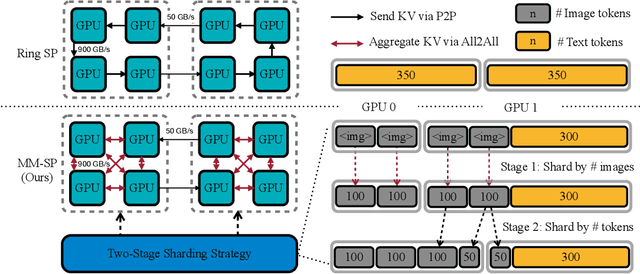
Abstract:Long-context capability is critical for multi-modal foundation models, especially for long video understanding. We introduce LongVILA, a full-stack solution for long-context visual-language models by co-designing the algorithm and system. For model training, we upgrade existing VLMs to support long video understanding by incorporating two additional stages, i.e., long context extension and long supervised fine-tuning. However, training on long video is computationally and memory intensive. We introduce the long-context Multi-Modal Sequence Parallelism (MM-SP) system that efficiently parallelizes long video training and inference, enabling 2M context length training on 256 GPUs without any gradient checkpointing. LongVILA efficiently extends the number of video frames of VILA from 8 to 1024, improving the long video captioning score from 2.00 to 3.26 (out of 5), achieving 99.5% accuracy in 1400-frame (274k context length) video needle-in-a-haystack. LongVILA-8B demonstrates consistent accuracy improvements on long videos in the VideoMME benchmark as the number of frames increases. Besides, MM-SP is 2.1x - 5.7x faster than ring sequence parallelism and 1.1x - 1.4x faster than Megatron with context parallelism + tensor parallelism. Moreover, it seamlessly integrates with Hugging Face Transformers.
TorchGT: A Holistic System for Large-scale Graph Transformer Training
Jul 19, 2024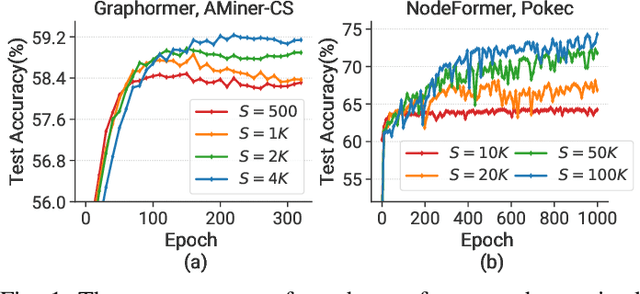
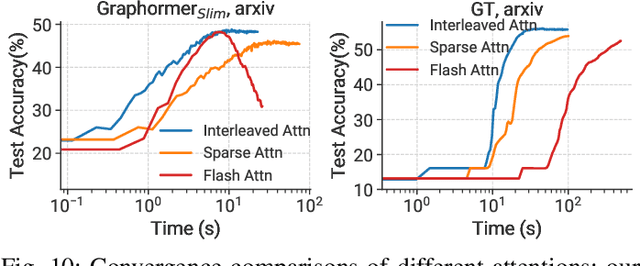
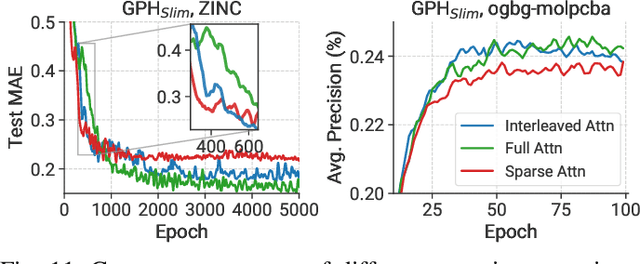
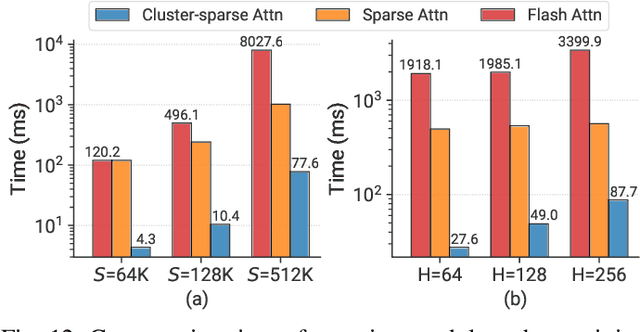
Abstract:Graph Transformer is a new architecture that surpasses GNNs in graph learning. While there emerge inspiring algorithm advancements, their practical adoption is still limited, particularly on real-world graphs involving up to millions of nodes. We observe existing graph transformers fail on large-scale graphs mainly due to heavy computation, limited scalability and inferior model quality. Motivated by these observations, we propose TorchGT, the first efficient, scalable, and accurate graph transformer training system. TorchGT optimizes training at different levels. At algorithm level, by harnessing the graph sparsity, TorchGT introduces a Dual-interleaved Attention which is computation-efficient and accuracy-maintained. At runtime level, TorchGT scales training across workers with a communication-light Cluster-aware Graph Parallelism. At kernel level, an Elastic Computation Reformation further optimizes the computation by reducing memory access latency in a dynamic way. Extensive experiments demonstrate that TorchGT boosts training by up to 62.7x and supports graph sequence lengths of up to 1M.
Characterization of Large Language Model Development in the Datacenter
Mar 12, 2024Abstract:Large Language Models (LLMs) have presented impressive performance across several transformative tasks. However, it is non-trivial to efficiently utilize large-scale cluster resources to develop LLMs, often riddled with numerous challenges such as frequent hardware failures, intricate parallelization strategies, and imbalanced resource utilization. In this paper, we present an in-depth characterization study of a six-month LLM development workload trace collected from our GPU datacenter Acme. Specifically, we investigate discrepancies between LLMs and prior task-specific Deep Learning (DL) workloads, explore resource utilization patterns, and identify the impact of various job failures. Our analysis summarizes hurdles we encountered and uncovers potential opportunities to optimize systems tailored for LLMs. Furthermore, we introduce our system efforts: (1) fault-tolerant pretraining, which enhances fault tolerance through LLM-involved failure diagnosis and automatic recovery. (2) decoupled scheduling for evaluation, which achieves timely performance feedback via trial decomposition and scheduling optimization.
MEGA: A Memory-Efficient GNN Accelerator Exploiting Degree-Aware Mixed-Precision Quantization
Nov 16, 2023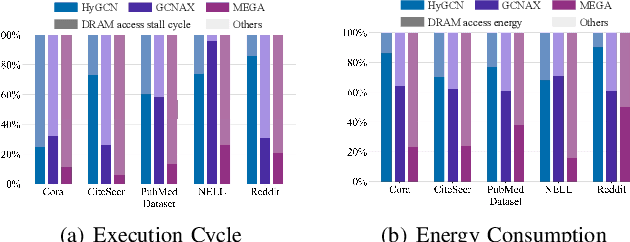

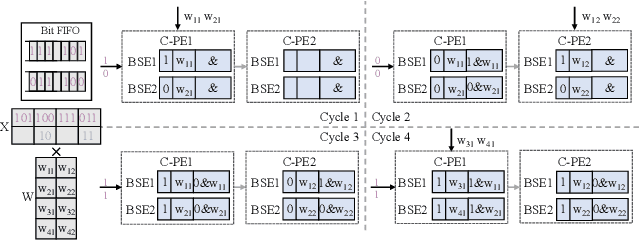

Abstract:Graph Neural Networks (GNNs) are becoming a promising technique in various domains due to their excellent capabilities in modeling non-Euclidean data. Although a spectrum of accelerators has been proposed to accelerate the inference of GNNs, our analysis demonstrates that the latency and energy consumption induced by DRAM access still significantly impedes the improvement of performance and energy efficiency. To address this issue, we propose a Memory-Efficient GNN Accelerator (MEGA) through algorithm and hardware co-design in this work. Specifically, at the algorithm level, through an in-depth analysis of the node property, we observe that the data-independent quantization in previous works is not optimal in terms of accuracy and memory efficiency. This motivates us to propose the Degree-Aware mixed-precision quantization method, in which a proper bitwidth is learned and allocated to a node according to its in-degree to compress GNNs as much as possible while maintaining accuracy. At the hardware level, we employ a heterogeneous architecture design in which the aggregation and combination phases are implemented separately with different dataflows. In order to boost the performance and energy efficiency, we also present an Adaptive-Package format to alleviate the storage overhead caused by the fine-grained bitwidth and diverse sparsity, and a Condense-Edge scheduling method to enhance the data locality and further alleviate the access irregularity induced by the extremely sparse adjacency matrix in the graph. We implement our MEGA accelerator in a 28nm technology node. Extensive experiments demonstrate that MEGA can achieve an average speedup of 38.3x, 7.1x, 4.0x, 3.6x and 47.6x, 7.2x, 5.4x, 4.5x energy savings over four state-of-the-art GNN accelerators, HyGCN, GCNAX, GROW, and SGCN, respectively, while retaining task accuracy.
Spiking NeRF: Making Bio-inspired Neural Networks See through the Real World
Sep 20, 2023



Abstract:Spiking neuron networks (SNNs) have been thriving on numerous tasks to leverage their promising energy efficiency and exploit their potentialities as biologically plausible intelligence. Meanwhile, the Neural Radiance Fields (NeRF) render high-quality 3D scenes with massive energy consumption, and few works delve into the energy-saving solution with a bio-inspired approach. In this paper, we propose spiking NeRF (SpikingNeRF), which aligns the radiance ray with the temporal dimension of SNN, to naturally accommodate the SNN to the reconstruction of Radiance Fields. Thus, the computation turns into a spike-based, multiplication-free manner, reducing the energy consumption. In SpikingNeRF, each sampled point on the ray is matched onto a particular time step, and represented in a hybrid manner where the voxel grids are maintained as well. Based on the voxel grids, sampled points are determined whether to be masked for better training and inference. However, this operation also incurs irregular temporal length. We propose the temporal condensing-and-padding (TCP) strategy to tackle the masked samples to maintain regular temporal length, i.e., regular tensors, for hardware-friendly computation. Extensive experiments on a variety of datasets demonstrate that our method reduces the $76.74\%$ energy consumption on average and obtains comparable synthesis quality with the ANN baseline.
Boosting Distributed Full-graph GNN Training with Asynchronous One-bit Communication
Mar 02, 2023



Abstract:Training Graph Neural Networks (GNNs) on large graphs is challenging due to the conflict between the high memory demand and limited GPU memory. Recently, distributed full-graph GNN training has been widely adopted to tackle this problem. However, the substantial inter-GPU communication overhead can cause severe throughput degradation. Existing communication compression techniques mainly focus on traditional DNN training, whose bottleneck lies in synchronizing gradients and parameters. We find they do not work well in distributed GNN training as the barrier is the layer-wise communication of features during the forward pass & feature gradients during the backward pass. To this end, we propose an efficient distributed GNN training framework Sylvie, which employs one-bit quantization technique in GNNs and further pipelines the curtailed communication with computation to enormously shrink the overhead while maintaining the model quality. In detail, Sylvie provides a lightweight Low-bit Module to quantize the sent data and dequantize the received data back to full precision values in each layer. Additionally, we propose a Bounded Staleness Adaptor to control the introduced staleness to achieve further performance enhancement. We conduct theoretical convergence analysis and extensive experiments on various models & datasets to demonstrate Sylvie can considerably boost the training throughput by up to 28.1x.
$\rm A^2Q$: Aggregation-Aware Quantization for Graph Neural Networks
Feb 01, 2023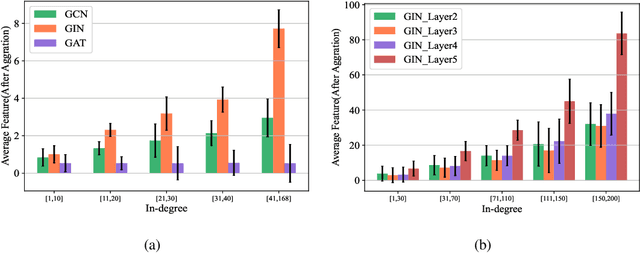

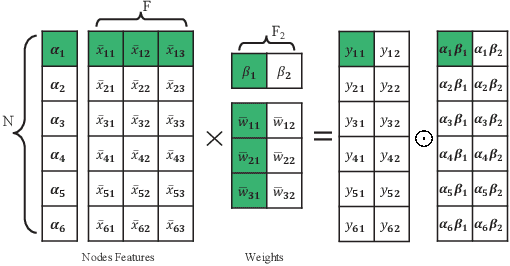
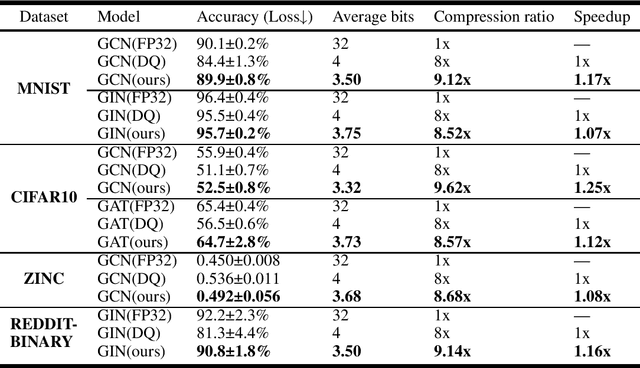
Abstract:As graph data size increases, the vast latency and memory consumption during inference pose a significant challenge to the real-world deployment of Graph Neural Networks (GNNs). While quantization is a powerful approach to reducing GNNs complexity, most previous works on GNNs quantization fail to exploit the unique characteristics of GNNs, suffering from severe accuracy degradation. Through an in-depth analysis of the topology of GNNs, we observe that the topology of the graph leads to significant differences between nodes, and most of the nodes in a graph appear to have a small aggregation value. Motivated by this, in this paper, we propose the Aggregation-Aware mixed-precision Quantization ($\rm A^2Q$) for GNNs, where an appropriate bitwidth is automatically learned and assigned to each node in the graph. To mitigate the vanishing gradient problem caused by sparse connections between nodes, we propose a Local Gradient method to serve the quantization error of the node features as the supervision during training. We also develop a Nearest Neighbor Strategy to deal with the generalization on unseen graphs. Extensive experiments on eight public node-level and graph-level datasets demonstrate the generality and robustness of our proposed method. Compared to the FP32 models, our method can achieve up to a 18.6x (i.e., 1.70bit) compression ratio with negligible accuracy degradation. Morever, compared to the state-of-the-art quantization method, our method can achieve up to 11.4\% and 9.5\% accuracy improvements on the node-level and graph-level tasks, respectively, and up to 2x speedup on a dedicated hardware accelerator.
DATE: Dual Assignment for End-to-End Fully Convolutional Object Detection
Nov 25, 2022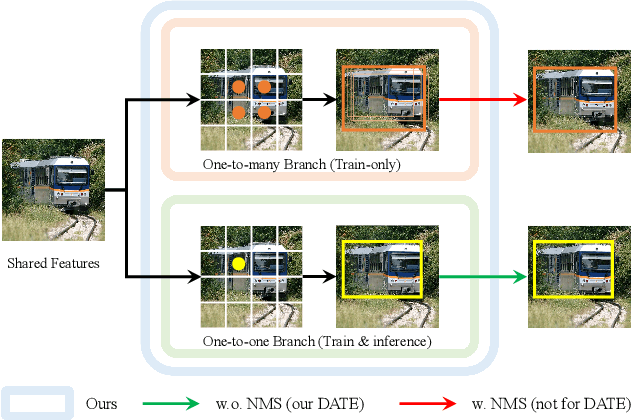



Abstract:Fully convolutional detectors discard the one-to-many assignment and adopt a one-to-one assigning strategy to achieve end-to-end detection but suffer from the slow convergence issue. In this paper, we revisit these two assignment methods and find that bringing one-to-many assignment back to end-to-end fully convolutional detectors helps with model convergence. Based on this observation, we propose {\em \textbf{D}ual \textbf{A}ssignment} for end-to-end fully convolutional de\textbf{TE}ction (DATE). Our method constructs two branches with one-to-many and one-to-one assignment during training and speeds up the convergence of the one-to-one assignment branch by providing more supervision signals. DATE only uses the branch with the one-to-one matching strategy for model inference, which doesn't bring inference overhead. Experimental results show that Dual Assignment gives nontrivial improvements and speeds up model convergence upon OneNet and DeFCN. Code: https://github.com/YiqunChen1999/date.
 Add to Chrome
Add to Chrome Add to Firefox
Add to Firefox Add to Edge
Add to Edge